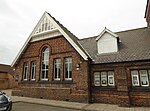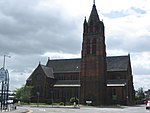Grove Hill, Middlesbrough

Grove Hill is an area of the Middlesbrough's Longlands and Beechwood ward in the Borough of Middlesbrough, North Yorkshire, England. It is a historic part of the North Riding of Yorkshire. The area's main shopping area is off Marton Road at the junction with Marton Burn Road and Belle Vue. The majority of the area was within the civil parish of Marton before the area and Marton itself became unparished areas of the town. Marton Grove Primary School served the area for 83 years before its closure in 2011 and demolition in 2012.They are also shops on the other end of Marton Burn Road, at the roundabout with Eastborne, Valley, Bishopton and York roads. These shops formerly had the Palladium cinema, demolished in 1960.Since the early 2000s, the area was subject to a regeneration scheme which saw many houses demolished. There was also a proposal to rename the area after ant-social behaviour had left the area with a reputation. The council stated that a "...rebranding would help create a place where people want to live".
Excerpt from the Wikipedia article Grove Hill, Middlesbrough (License: CC BY-SA 3.0, Authors, Images).Grove Hill, Middlesbrough
Farndale Crescent,
Geographical coordinates (GPS) Address Nearby Places Show on map
Geographical coordinates (GPS)
| Latitude | Longitude |
|---|---|
| N 54.5589 ° | E -1.2213 ° |
Address
Farndale Crescent
Farndale Crescent
TS4 2PJ , Berwick Hills
England, United Kingdom
Open on Google Maps






